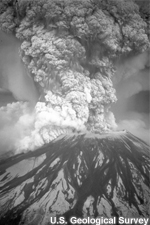Classification of Volcanic Eruptions » Plinian Eruptions

The most powerful eruptions are called "Plinian" (or even “ultra-plinian”) and involve the explosive ejection of relatively large amounts of viscous lava. It is named after Pliny the Elder who made observations leading up to the famous AD79 eruption of Mount Vesuvius, Italy. Large Plinian eruptions can send ash and volcanic gas high into the stratosphere from 33,000 ft (10.1 km) to 98,000-131,000 ft (30-40 km) or more. The resulting ash fallout can affect large areas hundreds of miles downwind. Fast-moving deadly pyroclastic flows ("nuées ardentes") are also commonly associated with plinian eruptions.
- A few well known Plinian eruptions of the 20th century include Mount Spurr, Alaska (1992); Mount Pinatubo, Philippines (1991); El Chichón, Mexico (1982); Mount St. Helens, Washington (1980); Agung volcano, Indonesia (1963).
- Some Plinian eruptions inject large quantities of sulfur dioxide into the stratosphere which is converted into aerosols and transported around the globe by high altitude winds. The aerosols block sunlight causing a slight decrease in global surface temperatures. Global cooling was detected with the eruptions of Mount Pinatubo, Philippines (1991), El Chichón, Mexico (1982) and Krakatau (1883) and Agung (1963), Indonesia. The massive eruption of Mount Tambora in Indonesia (1815), is thought to have caused the 1816 "Year without a Summer" in the northeastern U.S., Canada, and western Europe.
- It is important to know the location of Plinian eruptions because of their explosive nature and the amount of ash and gases that are injected high into the atmosphere. Those eruptions occurring in the tropics are more likely to have worldwide impacts as their aerosols will be distributed across both the northern and southern hemispheres.
